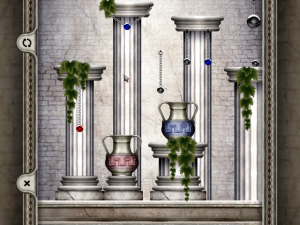Obulis
 I don’t seem to have any big-budget titles for 2008. Just as well — I tend to think of the last few years as typified by the triumph of the indie game. Obulis is a 2D physics-puzzler of a general sort that I mostly see for free on Flash games sites. But in fact it was originally designed for mobile devices, and consequently has a simplicity of interaction well-suited for touch-screens. The goal is to get colored marbles into their matching color-coded receptacles. Some of the balls dangle from chains (or, in some cases, rigid rods). You can select chains to cut them, allowing the balls to drop. And that’s all you can do. That’s the sole means of interacting with the game.
I don’t seem to have any big-budget titles for 2008. Just as well — I tend to think of the last few years as typified by the triumph of the indie game. Obulis is a 2D physics-puzzler of a general sort that I mostly see for free on Flash games sites. But in fact it was originally designed for mobile devices, and consequently has a simplicity of interaction well-suited for touch-screens. The goal is to get colored marbles into their matching color-coded receptacles. Some of the balls dangle from chains (or, in some cases, rigid rods). You can select chains to cut them, allowing the balls to drop. And that’s all you can do. That’s the sole means of interacting with the game.
In the simplest of the puzzles, you basically just decide on what order to cut the chains in, allowing the balls to come to a full stop before releasing any more. More advanced levels require you to cut chains while the balls are still in motion — for example, there might be a ball that drops onto a flat surface, where it needs a nudge from another ball to start moving, and the only way to apply that nudge in the correct direction is to release it in the interval between another ball rolling up a nearby slope and rolling back down again. The trickiest puzzles, the ones that I find myself having to restart over and over, are the ones that require collisions. One of the repeated patterns is to have a ball suspended by two chains in a V configuration, so that cutting either chain starts it swinging left and right, after which the exact moment that you cut the other chain makes a huge difference to its trajectory. So, it’s not just puzzle-solving in the sense of figuring out a solution, but involves precise timing as well, with small differences having large effects, the multiplier effect of an angle over distance. Solving levels like this involves more fidgeting and adjustment than problem-solving skills. Sometimes winning a level looks miraculous, the bodies in motion moving past or into each other perfectly. But then, the levels are all set up to make the solutions possible. Just knowing this, that everything was placed by the designer for a reason, helps a lot in figuring the puzzles out.
Knowing the physics helps, too. Collisions between balls here are perfectly elastic, like in a Newton’s Cradle: when a moving ball hits an unmoving ball on a horizontal surface, it’ll transfer all of its kinetic energy, coming to a full stop — but in a slightly different place. Slight differences of placement can be important if you’re about to drop another ball on top of that spot.
After less than a day, I find myself more than halfway through the game, and with more than half of its Steam trophies. I suspect that I’ll either finish this game very soon or not at all.
 Comments(0)
Comments(0)